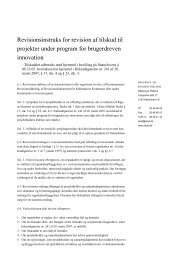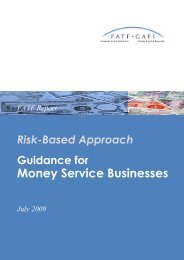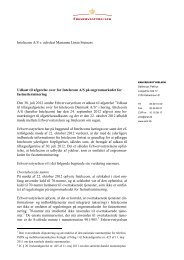By <strong>in</strong>creas<strong>in</strong>g <strong>SMEs</strong>’ access to technology, capital, product markets, among o<strong>the</strong>r th<strong>in</strong>gs,strategic alliances <strong>and</strong> o<strong>the</strong>r partnerships, as well as networks <strong>and</strong> clusters enable<strong>SMEs</strong> to comb<strong>in</strong>e <strong>the</strong>ir generally <strong>in</strong>herent fl exibility <strong>and</strong> ability to adapt quicklywith <strong>the</strong> advantages of scale <strong>and</strong> scope generally only available to large corporations.(OECD (2002a), p.21.)Box 7: On <strong>the</strong> Triple HelixThe Triple Helix model illustrated below was co<strong>in</strong>ed by Etzkowitz et.al. <strong>in</strong> <strong>the</strong> late 90’s, <strong>and</strong>provides a partly overlapp<strong>in</strong>g <strong>and</strong> partly complementary concept to <strong>in</strong>novation systems. Thetriple helix comprises universities <strong>and</strong> o<strong>the</strong>r knowledge-produc<strong>in</strong>g <strong>in</strong>stitutions; <strong>in</strong>dustry,<strong>in</strong>clud<strong>in</strong>g high-tech start-ups <strong>and</strong> mult<strong>in</strong>ational corporations; <strong>and</strong> government at variouslevels. While <strong>in</strong>dustry <strong>and</strong> government have traditionally been conceptualized as primary<strong>in</strong>stitutional spheres, <strong>the</strong> new element presented <strong>in</strong> <strong>the</strong> triple helix modelis that <strong>the</strong> university is posited to be a lead<strong>in</strong>g sphere along withState<strong>in</strong>dustry <strong>and</strong> government.The Triple Helix is a spiral model that is non-l<strong>in</strong>ear, nonstatic<strong>and</strong> that focuses on <strong>the</strong> <strong>in</strong>terplay between, with<strong>in</strong> <strong>and</strong>Industry Academiaoverlapp<strong>in</strong>g <strong>the</strong> actors to expla<strong>in</strong> <strong>in</strong>novation. Its focus isto distil <strong>in</strong> which way <strong>in</strong>dustry, universities <strong>and</strong> publicactors serve as <strong>in</strong>terrelated nodes <strong>in</strong> processes susta<strong>in</strong><strong>in</strong>gnew firm creation <strong>and</strong> <strong>the</strong> establishment of critical mass.The Triple Helix sees organisationally-overlapp<strong>in</strong>g <strong>and</strong><strong>in</strong>creas<strong>in</strong>gly flexible roles for <strong>the</strong> actors. Thus, <strong>the</strong> university can be seen as a firm founderthrough <strong>in</strong>cubator facilities; <strong>in</strong>dustry as an educator through company universities, <strong>and</strong>government as a venture capitalist.Source: Etzkowitz (2002)Whereas <strong>the</strong> notion of an <strong>in</strong>novation “system” may serve to broaden <strong>the</strong> scope of <strong>the</strong> policymakerto encompass <strong>the</strong> factors <strong>and</strong> reforms that may be most important for free<strong>in</strong>g up <strong>the</strong> potential for<strong>in</strong>novation – irrespective of <strong>in</strong> which policy doma<strong>in</strong> <strong>the</strong>y are found – <strong>the</strong> cluster approach focuseson a specific set of activities <strong>and</strong> how <strong>the</strong>y <strong>in</strong>teract. The implicit assumption underly<strong>in</strong>g <strong>the</strong> clusterapproach is that, if cont<strong>in</strong>ued, close network<strong>in</strong>g between geographically concentrated economicactivities with similar focus has <strong>the</strong> potential for bear<strong>in</strong>g fruit <strong>and</strong> improv<strong>in</strong>g <strong>the</strong> competitiveness of<strong>the</strong> actors <strong>in</strong>volved, as well as economic performance <strong>in</strong> a broader sense. The reforms that may bebrought about through application of <strong>the</strong> notion of <strong>in</strong>novation systems may be greatly important forfulfill<strong>in</strong>g <strong>the</strong> potential of clusters to develop, however. Reversely, <strong>the</strong> dynamics <strong>in</strong>herent to clustersmay represent important assets <strong>and</strong> mechanisms from <strong>the</strong> viewpo<strong>in</strong>t of policymakers concerned with<strong>in</strong>novation systems.Streng<strong>the</strong>n<strong>in</strong>g <strong>in</strong>novative clusters is not just a matter of promot<strong>in</strong>g network<strong>in</strong>g or ICT. Ra<strong>the</strong>r,successful clusters tend to <strong>in</strong>volve close cooperation between bus<strong>in</strong>ess, academia <strong>and</strong> government,<strong>and</strong> an element of knowledge creation <strong>and</strong> application which is highly collaborative <strong>and</strong> <strong>in</strong>ter-l<strong>in</strong>ked.O<strong>the</strong>r factors which play an important role <strong>in</strong> successful clusters are l<strong>in</strong>kages <strong>and</strong> <strong>in</strong>teractions captured<strong>in</strong> <strong>the</strong> triple helix model – <strong>in</strong>clud<strong>in</strong>g <strong>in</strong>ter-firm collaboration, public/private partnerships, <strong>in</strong>dustrysciencerelationships, <strong>and</strong> globalisation (for an explanation of <strong>the</strong> triple helix model see Box 7).54
Some <strong>in</strong>terest<strong>in</strong>g examples of cluster <strong>in</strong>itiatives <strong>in</strong> <strong>the</strong> Latvia <strong>and</strong> Lithuania are listed below <strong>in</strong> Box 8.Box 8: Examples of Develop<strong>in</strong>g Clusters <strong>in</strong> Latvia <strong>and</strong> LithuaniaIn mid-2001, <strong>the</strong> Latvian Information Systems (IS) cluster was set up, with <strong>the</strong> aim of ensur<strong>in</strong>gthat by 2010, Latvia would become <strong>the</strong> lead<strong>in</strong>g exporter of software, <strong>in</strong>tegration services, <strong>and</strong>outsourced services <strong>in</strong> Eastern Europe. Today, <strong>the</strong>re are 20 enterprises <strong>and</strong> organisations <strong>in</strong><strong>the</strong> cluster, <strong>in</strong>clud<strong>in</strong>g Latvia’s lead<strong>in</strong>g software companies, communication service companies<strong>and</strong> data centres, a test<strong>in</strong>g company, universities, a vocational tra<strong>in</strong><strong>in</strong>g centre, <strong>and</strong> web design,market<strong>in</strong>g <strong>and</strong> PR companies.Although <strong>the</strong> IS/IT sector <strong>in</strong> Latvia began consolidat<strong>in</strong>g before, <strong>the</strong> formation of <strong>the</strong> clusterwas facilitated by <strong>the</strong> project Support to Industrial Cluster Restructur<strong>in</strong>g (2000-2001) whichprovided consultative support to <strong>the</strong> process of cluster formation, recommend<strong>in</strong>g cooperationareas <strong>and</strong> assum<strong>in</strong>g <strong>the</strong> role of coord<strong>in</strong>ator or network broker, as well as help<strong>in</strong>g to def<strong>in</strong>e goals,strategies <strong>and</strong> jo<strong>in</strong>t values (collaboration, quality, competence <strong>and</strong> <strong>in</strong>novation) for <strong>the</strong> cluster.Recent evaluations of cluster members’ performance has shown that, on average, <strong>the</strong> companies<strong>in</strong>creased profits rapidly. Growth <strong>in</strong> turnover <strong>and</strong> profits was proportionally much higher thanoverall economic growth <strong>in</strong> Latvia (dur<strong>in</strong>g 2001). The focus achieved through <strong>the</strong> cluster<strong>in</strong>gprocess has lead to success: <strong>in</strong>dividual company revenues <strong>and</strong> exports have <strong>in</strong>creased, <strong>and</strong>productivity/utilization has <strong>in</strong>creased from 50-60% to 75%. Now, <strong>the</strong> cluster is prepar<strong>in</strong>g toexp<strong>and</strong> beyond national borders, establish<strong>in</strong>g a Baltic IS/IT cluster, aim<strong>in</strong>g to compete with<strong>the</strong> U.S. <strong>and</strong> India. Recently, <strong>the</strong> Baltic IS cluster participated <strong>in</strong> <strong>the</strong> <strong>in</strong>ternational exhibitionCOMDEX Sc<strong>and</strong><strong>in</strong>avia (<strong>in</strong> Go<strong>the</strong>nburg, Sweden, January 2004).In Lithuania, <strong>the</strong> Sunrise Valley Cluster was formed <strong>in</strong> May 2003 to contribute to <strong>the</strong> growthof <strong>the</strong> knowledge economy <strong>and</strong> <strong>in</strong>creased competitiveness of Lithuania. Initial f<strong>in</strong>ancial supportof €200.000 has been provided by Phare. Its objectives are to provide modern conditions forquality education <strong>and</strong> research, l<strong>in</strong>ked to professional activities <strong>and</strong> bus<strong>in</strong>ess environment;generate employment opportunities for highly qualified university graduates, scientists <strong>and</strong>o<strong>the</strong>r specialists; provide favourable conditions for commercialization of research; act as a l<strong>in</strong>kbetween science <strong>and</strong> technology parks <strong>and</strong> bus<strong>in</strong>ess <strong>in</strong>cubator systems <strong>in</strong> Vilnius; <strong>and</strong> providea basis for local <strong>and</strong> foreign <strong>in</strong>vestment for research projects.Found<strong>in</strong>g members <strong>in</strong>clude <strong>the</strong> University of Vilnius, Vilnius Technical University, Bité,EKSPLA <strong>and</strong> Alna. The Knowledge Economy Forum <strong>and</strong> Vilnius City Municipality are <strong>the</strong>public organisations who are support<strong>in</strong>g this effort. To date, <strong>the</strong> facilities <strong>and</strong> <strong>in</strong>ternationalnetworks have been established; future efforts will be concentrated on streng<strong>the</strong>n<strong>in</strong>g <strong>the</strong> br<strong>and</strong><strong>in</strong> order to encourage a physical concentration of high-tech bus<strong>in</strong>ess establishment (primarily<strong>in</strong> laser photonics, IT, medic<strong>in</strong>e <strong>and</strong> biotech). Sunrise Valley is also try<strong>in</strong>g to f<strong>in</strong>d ways tocollaborate with o<strong>the</strong>r Baltic <strong>and</strong> Nordic countries, both to experiment with o<strong>the</strong>rs’ concepts<strong>and</strong> to f<strong>in</strong>d ways to <strong>in</strong>crease <strong>the</strong> level of collaboration (beyond sales/trade).The state of each nation’s cluster development <strong>in</strong> <strong>the</strong> B4 is quite varied. Their rank<strong>in</strong>g (Table 13above) highlights <strong>the</strong> “newness” of this realm of enterprise development <strong>and</strong> <strong>in</strong>dicates considerableroom for improvement when it comes to streng<strong>the</strong>n<strong>in</strong>g cluster <strong>in</strong>itiatives <strong>in</strong> <strong>the</strong>se countries.55
- Page 1 and 2:
Sylvia Schwaag SergerEmily HanssonC
- Page 4 and 5:
About the International Organisatio
- Page 7: PREFACEAccession to the Single Mark
- Page 10 and 11: enterprise development. There are n
- Page 12 and 13: BOXESBox 1: The ‘Knowledge-Based
- Page 15 and 16: INTRODUCTIONAfter more than 10 year
- Page 17 and 18: CHAPTER 1: FROM STABILISATION TO IN
- Page 19: increased competitive pressure as B
- Page 22 and 23: Box 2: On Innovation and Innovation
- Page 24 and 25: Table 5: GDP Growth 1995-2003 in Se
- Page 26 and 27: Table 7: Relative Strengths and Wea
- Page 28 and 29: Box 3: The Indicator ProblemExistin
- Page 31 and 32: CHAPTER 2:BALTIC SMEs - AGENTS OF F
- Page 33 and 34: Table 9: Average Annual Growth of S
- Page 35 and 36: Box 4: Overview of Selected Multina
- Page 37 and 38: The Role of SMEs in Transitional Ec
- Page 39 and 40: e to the potential advantage of the
- Page 41 and 42: A common measurement of business ac
- Page 43 and 44: Figure 8: Labour Productivity per P
- Page 45 and 46: Figure 10: Employment in Med/Hi-tec
- Page 47 and 48: Summing up, there are fewer economi
- Page 49 and 50: Overall, SMEs tend to lack the fina
- Page 51 and 52: Figure 12: Enterprises with Innovat
- Page 53 and 54: Figure 14: Proportion of Enterprise
- Page 55: Table 14: Barriers to Innovation fo
- Page 59 and 60: CHAPTER 3:POLICIES PROMOTING SMEs A
- Page 61 and 62: National governments themselves wil
- Page 63 and 64: Institutional StructureIn all of th
- Page 65 and 66: EU countries (innovation relay cent
- Page 67 and 68: LITHUANIAAgency/OrganisationLithuan
- Page 69 and 70: From the private sector, the chambe
- Page 71 and 72: On the whole, the B4 have relativel
- Page 73 and 74: LITHUANIAProgramme/Policy DocumentI
- Page 75 and 76: Table 19: B4 National Rankings of A
- Page 77 and 78: Box 11: Structural Funds to the Can
- Page 79 and 80: Box 12: On SMEs and FinancingIt doe
- Page 81 and 82: examples of evaluations of national
- Page 83 and 84: CHAPTER 4:CHALLENGES AND RECOMMENDA
- Page 85 and 86: General challengesBased on our own
- Page 87 and 88: the above-mentioned channels. 27 On
- Page 89 and 90: the EU average and particularly wit
- Page 91 and 92: RecommendationsBased on the challen
- Page 93 and 94: CHAPTER 5:A VISION OF A NORDIC-BALT
- Page 95 and 96: addition, they are the most advance
- Page 97 and 98: countries. One such sign is the rap
- Page 99 and 100: CONCLUSIONSEU accession will not re
- Page 101 and 102: REFERENCESAlfonso, Antonio, Ludger
- Page 103 and 104: European Commission (2003f), Compre
- Page 105 and 106: Eurostat (2004a), SMEs in the Candi
- Page 107 and 108:
Statistical Office of Estonia (2004
- Page 109 and 110:
APPENDIX I:Agenda for Working Group
- Page 111 and 112:
DAY 2:POLICY SOLUTIONS9:30-10:30 In
- Page 113 and 114:
APPENDIX II:Participants in the IKE
- Page 115 and 116:
APPENDIX III:Conclusions from the I
- Page 117 and 118:
APPENDIX IV:Summary of the Panel se
- Page 119 and 120:
Regarding the role of policymaking,
- Page 121 and 122:
APPENDIX V:Description of Field Stu
- Page 123 and 124:
Mr. Miroslaw MarekMr. Talis Millers
- Page 126:
IKED - International Organisation f
















